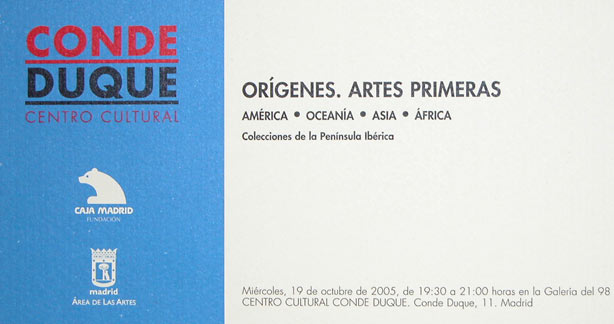Interview conducted and written by Michael Auliso and republished here with his permission.
Antonio and Ana Casanovas own the gallery “Arte Y Ritual” in Madrid Spain. Antonio is considered by many to be the preeminent dealer in the field of tribal art today. He earned his reputation by selling significant pieces of the highest quality possible. He is also known for buying and selling fine objects at extraordinary prices. On Saturday morning September 17th 2004, I met with Antonio during the Parcours des mondes tribal fair in Paris at his gallery at 11 rue Visconti. We are honored to present views on Tribal Art from “Antonio Casanovas”…
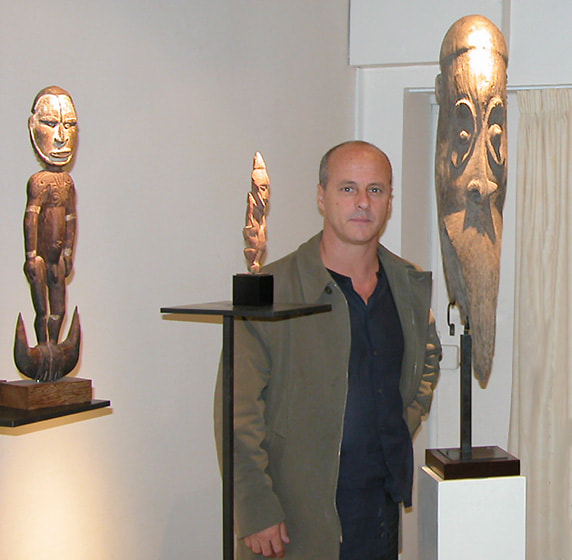
Antonio Casanovas
TM: How did you get started?
Well, I am very bad with these kinds of dates, but I would have to say that the art world was really my start. Art in general is universal and either you are into art or you are not. If you are, you will find your own area of interest in art. Thanks to my parents who were collecting contemporary & Asiatic art, as a kid I saw a lot of art around my house. I suppose this was my real start.
I was lucky to be born close to the only great collection that was in Spain, and my sister was a good friend of the daughter of these people who had a kind of private museum. So we kids would go and play around the New Guinea objects or African masks. At five years old not only were these things a curiosity for me, but they stayed in my mind as well.
At a later date, of course much later, I was working at something else, traveling in Indonesia. Wherever I traveled, I used to buy antiques. The first Indonesian sculpture of tribal art I bought in 1982.
TM: Were you field collecting there?
CASANOVAS: I was not looking for art at that time, I was actually traveling around that beautiful country. I went to some of the far islands, and there was a small dealer, a Chinese man who had ten sculptures from some village. I saw them when I was with my girlfriend, and we both flashed on those things, which we started to relate to Picasso, how they looked like Picasso. I still have one of the pieces; it looks like a Picasso painting. I didn’t have the money to buy them, so we decided to convince the guy to come to Bali with us, and then to wire the money to his bank, so we kept him suffering for 15 days, but the money arrived (laughs) and that was the beginning of our collection.
I got started as a collector, and a few years later, I kept taking those trips, in the field, and I started going to museums, got interested in books and so forth. My Dealing career started when a big collector in Barcelona found out that I had a collection of these, and wanted to visit me. He came to see me, from then he started to bug me to sell him some pieces. At one point I said “look I don’t know what they are worth, I know what I paid for them, how much can I ask?” He said “well, I’ll make you an offer” And he offered me…..well it was a nice surprise, so I said on the next trip, I will buy for me and I’ll buy for him. So that’s how I started dealing.
Then of course I realized what the reality of the market was, you know Bali, and the fakes, and I decided I needed to learn more. I started working with another much more experienced dealer, we started to buy together, and sell to his clients. So I could really go deeply into study. He was really the person who taught me the business. Then we started to go to the Paris & Brussels, auctions.
TM: Is this the only business you are involved in?
CASANOVAS: Yes, it is full time. I was really excited that I found something I love and can make a living from. It was always my dream to work at something I love. The first time I saw those tribal sculptures, it was immediate love. I had contemporary art all through my life, and I still collect it, but I didn’t get the…as you say in America…the “kick” that I get from tribal art. It is like “Wow!” you know? It is something else, it connects with my spirit.
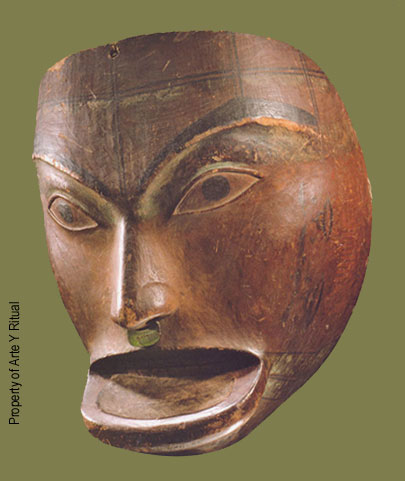
Northwest Coast Tlingit Shaman’s Mask Circa 1780-1840
TM: Do you maintain a personal collection?
CASANOVAS: You see, I buy what I like. I think all my stock is my personal collection. If I sell they go, they find another home, and if not they come back home and they are very happy too. So that’s why I like to buy things that I like, because in our business things may not immediately sell for whatever reason, not because they are not good but because the buyer is not there, they need some time to see it, to learn about it, so things stay around. I like to surround myself with beautiful things, so that’s why I say my stock is my collection.
There are some things I hold onto until the right time comes to sell course. Things that are undervalued and are masterpieces and I’m not ready to let them go at the value of the market so I wait until the right moment. More or less that happens in every culture, people are conditioned to the idea of that the culture should be that much or this much and so I have a different view of this. You know there’s always been Picasso born in every culture. It can be a very important culture and be a piece wood, or it can be a lesser culture and be a masterpiece.
I have tried to price things at the level of their art, not so much only history, provenance, importance of the culture… of course that’s the market and we are more or less applied to this market but that doesn’t mean I’m always going to decide to follow them.
TM: It’s been said that behind every great man there is a great woman, to what degree do you attribute your success to your wife?
CASANOVAS: In my life this is totally true. Not so much because Anna discovered primitive art through me, even though she had seen some exhibitions. She was living in California for awhile actually, she saw some exhibitions there and she had already fallen in love with it before she met me. I was already in the business when I met her so she discovered more through me. But my wife of course is more important than any art work in the world. At the same time she’s been my good luck, my pillar. First she has always said yes to every crazy adventure I went on, and to every expense for a few months. She never said “no, this is not a prudent thing to do”, but this is the great thing ~“I believe in your eye, and go for it.” She’s very supportive.
And through the years she has acquired a very good eye herself. It’s always a great help to have another opinion on things. You know I believe that couples, the more they live together, they become one entity. This is the same with us, so now we really have the same taste, 95 percent of the time we like the same objects, so we agree quite easily. Sometimes I still like things that go a little bit further on the wild side, and she says “I don’t know about this” but I still buy it. After a week she says “well” but those times are very seldom, most times we agree and she helps me in everything, she works with me all the time.
So I’m much more stable as a person in a way, I’m a bit more of an artist and she’s more steady. So in moments of ups and downs, she’s there, and I just have her force, she’s much stronger than I am.

Modang Sculpture, Borneo (Carbon dated to the 14th C.)
TM: What else do you attribute your amazing success to? You must be a really motivated person as well. Did you set out to be number one?
CASANOVAS: I must say I don’t see it that way, at least I don’t recognize it. I started out because I loved it, first as a collector, then as a business, and it became my life. Everything was Tribal Art. So the intension was to live from something that I love, and that from the beginning was clear.
I don’t even remember the first tribal show we did in New York; it was maybe ten years or so ago. That was the first International show that we did. And I thought we were just going to arrive there and we would all be like “wow!” what incredible pieces there are here… But actually I sold most of what was in my booth, and people were very excited about what we were bringing. Some collectors were there and one of them bought half of my booth! So I realized that I could do the job internationally. Before I thought I was just a little Spaniard in Spain and I’m doing what I can but I thought that maybe people were appreciating what I was doing more than I did. But then there is another thing which is not a very good thing, but perhaps it is, that is being a perfectionist. It’s not because you are never satisfied as a human being it is not a very good recommendation, but in art the search for that kind of perfection, which is never there, but the search makes you push as far as you can go.
But I do only enjoy buying and dealing in the things that I really like. So I use the best of my ability to buy, then if it is recognized and the people follow me, that is after. Then I show it, and you are right, we were quite surprised, in these last years, how our career has developed very fast.
TM: that leads me into my next question, many people in the tribal art community consider you to be the biggest dealer today.
CASANOVAS: I don’t know. You know I don’t like that term “the biggest dealer” to be honest because that puts me into a situation. To me the biggest dealer moves the most objects for the most money. This is not my aim. My aim is quality. I don’t think selling only great quality you make as much money as selling every type of object. So I will never become the biggest dealer in the world in this sense, but I hope to have a name and reputation for pristine quality. I’m serious about that. What I earn from this brings me enough to play with the pieces I like and to live well. I don’t need much more than I have in a way… I like to be surrounded by beautiful things and today beautiful things in certain areas are expensive and I just have to find a way to have access to them, and this has taken me quite a lot of work, but if you aim at something you usually get at least part of it. I don’t believe I’m the biggest or the best because there are always a few people in the world that are good at what they do and that makes them different. It is like saying what is the best Picasso in the world? There are several great Picasso’s so you can’t just choose one and this goes for dealers also.
TM: I mean, you’re an important dealer, you sell important pieces…
CASANOVAS: You know the quality I like nowadays, many times not always, involves serious numbers if you want to have access to that kind of quality. If I started in Modern Art today and wanted to buy Picasso’s for 20 million dollars I could not with my means but I could probably get into that art community somehow and end up at that level someday. This is what has happened in tribal art. I search for a certain quality and then must find the means to buy it. Then of course you become important in this sense because you are selling important things.
TM: Did you set out to become this successful or did this happen naturally?
CASANOVAS: A long time ago a very good friend from my youth told me that I said that I wanted to be one of the biggest dealers in the world. I promise you I don’t remember that subject and perhaps it was one night after a couple drinks. I’m not conscious of this but maybe I did say this? He is my good friend and I must trust him. I think somewhere in my mind is perfection and I want to do it the best I can whether it is being a dealer or whatever. The truth is what makes us a little different is that we choose art with a passion like the old time dealers. Years ago when there was a large choice of objects it was easier. You didn’t need to buy what was easy to sell; you could follow your heart and develop your eye. Ratton had his own distinct eye, Pierre Loeb had his own eye, and every dealer had his own eye then because more material was available for personal choices. Nowadays it is much more complicated because things are recognized, things are classics.
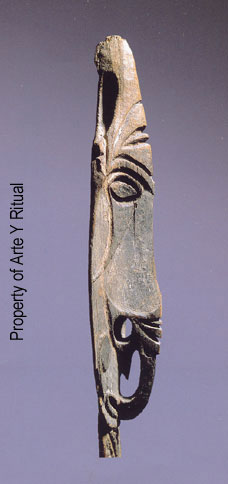
New Guinea Blackwater River Hook
TM: You’re known for being very aggressive when you want a piece. Do you feel that is one of your strengths?
I think this has to do with astrology. I’m a Taurus which makes me very persistent, very stubborn and tenacious. People that have great objects, somehow they feel flattered that somebody is so passionate about their piece. I think that has brought me many times great pieces. Well they are people who love their things, you know. The collector may have lived with the piece for 30 years, and will consider to let it go, to let go of one of their best pieces, because that’s the one I want from their collection. I’m not saying they are going to sell it to me for less, but at the same level they would rather let it go to someone who is really in love with the piece, and that love brings you things.
TM: One of your good friends told me he’s convinced you possess “shamanic powers”.
CASANOVAS: There is a magical side of our business. If I do have something like that, I would not like to show it off. First as I said I am not conscious about this. I do believe that things have happened; I do know that things have happened in my search for pieces that you could call quite magical. I don’t believe in just accidents. Things that were supposed to go somewhere else came to me. That has happened many times. I’m not a fortune teller. I don’t have that power, at least not consciously.
You can not forget that we are dealing with pieces that are fully spiritual, and those pieces somehow “know” where they want to go. I’ve had sometimes a really strong desire to get something…not something that I knew about, but something that I thought in my dreams, I would like to have a great piece of this or that, which seemed practically impossible to get…. Suddenly out of the blue something comes out in that area that is even more than I could expect. So desire and Love are powerful energies, and I do have those.
TRIBALMANIA: How do you balance the ego with spirit?
CASANOVAS: Spirituality is a long journey. There is also probably a part of ego in my career maybe. A little bit of ego is necessary. We are on the Earth, not in Spirit; ego well taken care of is a powerful tool too. I cannot say I have no ego, no, but there is a moment when it can make you go forward searching for a goal. But it is not my main focus.
PART 2
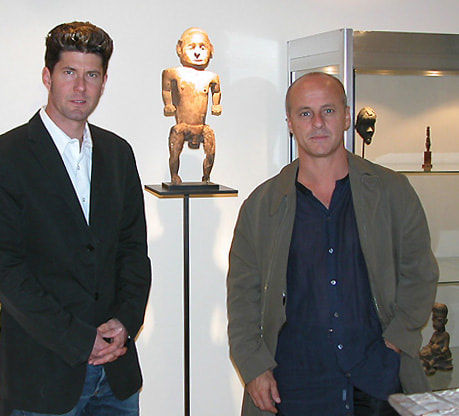
Michael Auliso and Antonio Casanovas (Center) A rare and important Flores male ancestor figure
TM: Just about every dealer in this business dreams about having the kind of special clients you do. What would you say to them?
CASANOVAS: First I would say that the garden next door always looks greener than yours. This is true. People think I have thousands of clients and this is not true. I have my few people that I connect with and share the same passions. They trust me and I trust them and we go along together and they happen to be people that are able to afford rare things. I really don’t think I’m doing anything different than other dealers, but I don’t follow them anyway. The way I run my business is not the way to make a lot of money. I will have enough money to play with what I want and what I like– I hope. My recommendation in this business for somebody who really wants to become a dealer is to move as much objects as you can everyday and to sell to every level and to every client. The thing is that I don’t get excited about buying certain pieces. I never buy a piece because it is a good piece to make money on. I never do this–I only buy when I love something. If I arrive at the point of buying for profit only, that is when I will stop being a dealer. Of course I’m happy if I can make a good profit but this is never my first concern. My aim is to enjoy want I’m doing.
TM: What percentage of your sales are to Europeans verses Americans?
CASANOVAS: I would say half and half more or less. It depends on what types of piece and the client. I work with a limited clientele, but they are all over the world.
TM: Do you find it easy to maintain good relations with other dealers?
CASANOVAS: More or less yes. You know, there are moments of friction and natural jealousy that happen sometimes… some natural and some less natural. In fact I have good relations with most of them I would say, as long as they are serious and not a crook or somebody that is trying to do some nasty things to you… slowly I would probably not see this person so much. But I must say that I have very few dealers who I can say that about. But of course in the battlefield of the market (laughing) there are a lot of things going on, it is a very small world and sometimes the friction makes people criticize some pieces or whatever. This is something I try to avoid honestly and I think energetically this saves me from a lot of trouble. If there is somebody I don’t like, and they have a beautiful piece I will never say different… I will say yes it is a wonderful piece. I think it comes back to you if you try to kill an object which is great, because you are not respecting the art. Above anything you must respect the art that we are dealing with. So if it is good and is in the hands of anybody else I’m happy for them.
TM: What criteria must an object have for you to buy it. Do you have a philosophy on buying?
CASANOVAS: My only philosophy is that I must like the piece for myself. Of course the judgment of an object involves other things too. You have to judge the sculpture within the corpus of other pieces around the world. Once you like it then you have to see what level the piece is. Imagine a Fang figure… You’re in front of it and you ask what is the corpus of other works? If it is not available maybe I’ll buy something else but I’m not going to buy a mediocre piece if the good ones are not available; I’ll look for another venture. There are many areas of the world which are not yet as famous and they created some wonderful art. These are some of the areas I like to concentrate on because you can still discover and I like that– the discovery of something that is a little bit neglected by the market is great. The value of tribal art is a difficult subject. There is not a written price list of what things should be worth and when. Many times in my case if there is a top piece and I want to buy it, there is a tendency to maybe over pay a little bit of the “so called” market price. But I mean it is just a “so called” market price. Sometimes it is a once in a lifetime piece, you have a chance to buy it and if you don’t somebody else will and then it is gone. I have paid prices that are way above the market but if it is a masterpiece I will just hang onto it or if one of my clients recognizes it, maybe he will follow me if they see the piece in the same way as I do. My clients follow me and I follow my clients. Sometimes I have to show them what I’m seeing because maybe they won’t see it the same way. So I’ll have to do my job also and say look here and look at other examples in the world and compare. This is the job of a dealer to educate your client. The more you educate your client the more they will understand what you offer them.
TM: What inspires you to keep finding and offering great pieces for sale?
CASANOVAS: I enjoy finding pieces. I’m a temporary collector– we are all temporary collectors, but I spend less time than others you know. I enjoy the art and take it home with me like my own baby, and look at it and WOW I have a wonderful time. Sometimes I’ll have it a few weeks, a few months or a few years but at some moment it is offered to my client then it goes or it doesn’t go. I absorb and learn what I can from a piece then look for the next adventure. It is the treasure hunt and finding that new thing– that excites me.
TM: What would you say the most important object was that you’ve sold?
CASANOVAS: The most important or expensive which you’re asking me, I prefer not to say exactly. It was an Oceanic piece. There is an African piece that is about the same also. They were both “world class” masterpieces and the best of their type. Classical pieces like this make a lot of money today… what is known, what is studied becomes a classic. From time to time they come through my hands and those are the ones that are more expensive. This will happen to some pieces which we are buying today for 2000 Euros. In the future people will recognize them as the best and their prices will go Zoom!
TM: What advice would you give to new collectors just starting out?
CASANOVAS: Well I would advise that they should buy what they like first. They are going to have to live it for better or for worse. Everybody doesn’t start buying masterpieces, you know you have to go through a process to arrive at a certain level. My advice is that they enjoy it and buy from a dealer that is serious and who they have trust in. The most important thing is that you have the passion–go out there and learn. See as much as you can, go to shows, go to museums, buy books and train your eye. Somebody can have a great eye but if he doesn’t train it he is only at half of his potential. If you have the passion for art and you work to train your eye your potential is vast. Ana and I have been more or less all around the world visiting the museums and storages and exhibitions. The last time we were in Germany we spent one month visiting all of the museums and their storage. We spent three days in Berlin.
If you want to do something bad enough, ninety five percent of the time you will get it– no? Sometimes I have arrangements with my government’s museums so I get letters from my own museums to allow me to do personal research. It is incredible how good this is for your eye. So when a piece comes in front of you that you have to acquire, all of that information starts coming at one moment and you see that this one is shining from all that information that you have. Or you may say no, I’ve seen a better one.
TM: Do you think the market for Tribal Art is expanding or contracting? Do you see new collectors becoming interested?
CASANOVAS: I think it is expanding. The only problem is that we will see is that some of the very good things are becoming much more expensive. I have a total belief that we will see the pieces of primitive art, the top pieces, at the price level of any other form of art. This is already happening, but for me I have the feeling that this is only the beginning. In the interview you did with Saul Stanoff who had a very good eye and judgment of the pieces, I agree with him that this is only the beginning of the explosion. So some classic pieces will only be accessible for museums and those people with means. But that doesn’t have to discourage new collectors because there is a lot– a lot of new possibilities of cultures that are known in African, Tanzania, Indonesia etc. There are many new areas in the market which have not been discovered yet. I mean in the market not in situ.
You can still buy wonderful things for a 1000 Euros. I enjoy to buy a piece for 1000 Euros than to buy one for a million. I bought one piece recently in a Christies Auction that was in a bundle of little Spatulas. It was a hair pin from New Guinea. I paid nothing for it, $1800 dollars or whatever it is a masterpiece! It is just a cute little thing but it is incredible. I mean it comes form a very old English collection and has the feeling of the pieces that are in the great museums. It gives me as much pleasure as a major piece. So there are always pieces to be found which don’t have to be a million. I still buy ethnographic things that are not sculpture which are beautifully done that have a master behind them. It is that quality that gives me great pleasure as well, so you have to not get carried away and only buy expensive things. I buy whatever is good.
TM: You’ve been known to offer collectors some very high prices for pieces you’re interested in. Do you ever feel bad about separating a collector from a piece they love?
CASANOVAS: I know what you’re saying. Maybe I do feel a little bit bad about it because the person who is selling it to me is suffering somewhat. My egocentric side feels happy because I’m receiving the piece. But I’ve never done this in a way that it was a forced situation. It has always been to show them my appreciation for the piece. Sometimes I pay over the “market price” and this says that I really love and appreciate that object. A person will let it go out of total necessity sometimes but many times it is because they say ‘Wow, he is crazy for my piece’. So in fact they have some sort of sorry feelings to let it go, but at the same time they know it is going to someone who is passionate for that object. This same thing has happened to me. When I sell a great piece, don’t believe that the check makes me so happy. At that moment I feel sorry that my baby is going away, but the person buying it loves it so much that some of the pain goes away.
Great pieces also happen to come back to you. It is not the first time that I’ve had to re-buy back things for much more than I sold them for. In a way it is a bit sad because I usually don’t have an attachment to the pieces I’ve previously sold to clients. I’m happy when I go to them and offer them double or more than what they paid for it and they still don’t sell it. In a way I feel honored that they don’t sell it to me at whatever price since they really love the piece. It is sometimes a surprise to me but it is nice to see.
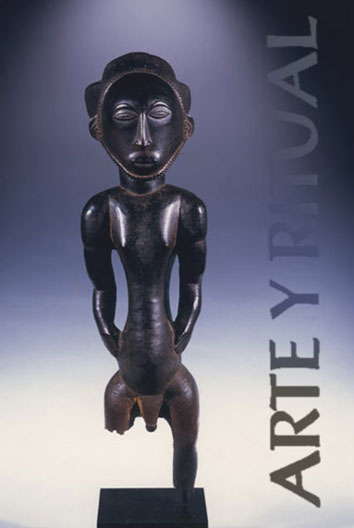
Antonio’s Website ARTE Y RITUAL (www.arteyritual.com)
TM: I’ve heard that you’re a skilled salesman. Do you have any special technique for closing a sale?
CASANOVAS: Hmm… People say I’m a good salesman and I suppose I am because I do sell things. I think my passion helps me with eighty percent of the sale. I think the information and really knowing what I’m talking about helps another ten percent and then maybe I do have ten percent of a general salesman too somewhere which does the rest. When you love your pieces, clients feel good about buying from you and I vibrate this.
TM: What are your thoughts on restoration?
CASANOVAS: I must say I really don’t like to restore pieces myself, unless it is something that I’m not even going to see. I’m not sure if I express myself well. Imagine if something has the hand and the rest of them and you only have to fill in half a centimeter and it would make you lose a hole which was never intended to be there, and you’re not going to see that. You’re not trying to hide it. For me a restoration even if it is great, many times disturbs my eye. I just keep seeing it and seeing it all over again.
It really depends on the piece. Some pieces may need a restoration to be complete and others don’t. I’ve seen too many pieces that were over restored that didn’t need it. I’ve bought many pieces that were restored and took out the restoration because it kept disturbing me. I bought a nice piece last year that had a new thing put on the head and I took it off immediately. You could see it right away and it didn’t need it. I prefer to see all the way through the object at the master hands, and whatever is missing is missing. It is an old object so what can you do about it because the restorer has his own hand which is nowhere near that of the original artist who made it. Of course you have to be very careful nowadays because there are some very good “artist restorers” who are quite skilled. So I buy pieces and know they are restored and I accept that because I know it is the best of its type and what can you do about it. Restoration is in demand too because if you restore a little area on a piece you can get it sold.
TM: I think some people may perceive you as mysterious and enigmatic. Is there anything in particular you would like people to know about you?
CASANOVAS: I think I’m quite open, not so much mysterious. We’ll, maybe I do protect myself a little bit in the sense that I know there are all these things happening and energies going on. It is a small world where there are conflicts of interest. So I try to be professional at this and not to “over show” things and not leave myself completely open. I do protect my intimacy a little bit but without closing the door because I’m open to many people. As I’ve said, with most of the dealers I have good relations with even though we may have conflicts in the market at some point. I’m a good loser. If I lose a client because somebody has talked something bad about one of my pieces, I’ll say well it was not for him. I will defend my piece, but I’ll also just accept things. There are some disastrous people who are doing some very bad work, but most people are doing the best they can in this job. I must say this is probably the part I like the least because it doesn’t help anything.
TM: What do you do to relax when you’re not selling tribal art?
CASANOVAS: That’s a good question. Well my children which are my family… we have a little country house. I have a few objects there to keep my love around, but I try not to be so accumulative there and to enjoy nature and other things. I love, like everybody else, to be with friends. In my spare time I play music with friends. I’m a percussionist also. Drumming is my passion. It is very good and I recommend it to many people. It liberates excess energy and gets you out of your head for a moment. It is an active meditation. I think anything you do with a real love is a kind of meditation. I really love music, and it takes me away into another space you know.
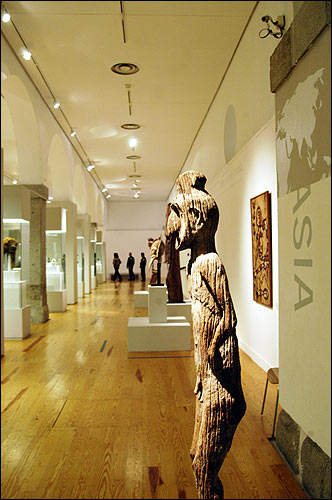
“Origenes Artes Primeras” Exhibit at the Conde Duque Centro Cultural, Madrid Spain
TM: What are your plans going forward?
CASANOVAS: (Origenes Artes Primeras). We are the curators and have selected the “best” pieces in our judgment for the government. The scope includes 140 objects from North America, Oceania, Indonesia and Africa. It was fun visiting and selecting pieces from the museums of these countries. There will be some discoveries to the tribal art world which have never been seen. Other pieces are famous of course, Chokwe and Congo pieces from Portugal. That is our next goal. They are a lot of work and economically they don’t pay but we enjoy it. The hardest part is dealing with certain Museums and the problems of loans and this and that. Without being nationalistic, my country owes a lot to these tribes for many years and sadly we have not done much with their art. So this is a tribute to these artists. I would like this project to crystallize into something similar which has happened here in France. I hope to one day see major museums have tribal art sitting next to any other world masters. I want to encourage the politicians of Madrid to open up their minds about this a little bit. Hopefully this will do the job.
Tribalmania extends its sincere gratitude and appreciate to Antonio Casanovas for sharing his time and candid views of the tribal art scene.
